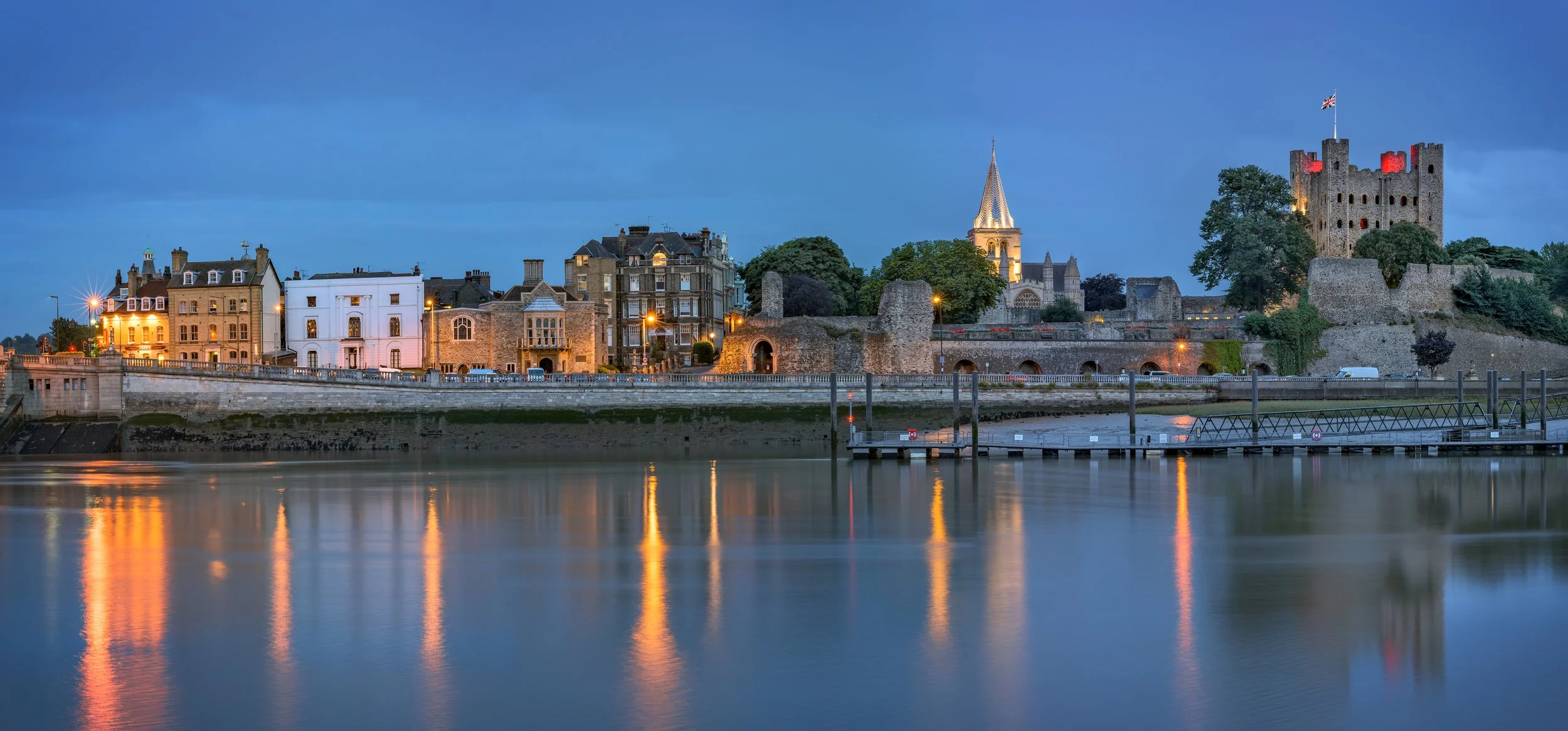History of Rochester
The history of Rochester
by Ben Johnson
The City of Rochester has grown from a small Saxon village to one of England’s finest cities. Romans came over in 43AD and made Rochester one of their most important towns by building a stronghold and a bridge over the River Medway.
It wasn’t until 1088 after the Norman invasion that Rochester had its first stone castle built on the remains of the old Roman Fort.
The then King, Rufus asked his Bishop Gundulf, an architect, to build him a stone castle and later a magnificent Cathedral, which is the second oldest in the country. Bishop Gundolf also built a leper hospital namely St. Bartholomew’s which was the oldest hospital in the country, albeit the original hospital has since disappeared.
One of Rochester most famous connections is that with Charles Dickens. His family moved to Chatham when his was five years of age. After moving away from Chatham he later returned to Gad’s Hill place in Higham. By then many of his novels were published and read around the world. However, he died whilst writing his novel “The Mystery of Edwin Drood”. Many of Dickens novels included references to Rochester and the surrounding area where today two festivals are held in his honour, the Dickens and Dickensian Christmas Festival.
Many other festivals are held in Rochester: from May, with the ‘Sweeps Festival’ , July with the Summer Concerts held in the castle grounds, through to the ‘Dickensian Christmas’ and the lamp light procession through the streets of Rochester.
Not only are there celebrations and festivals going on throughout the year, there is also Rochester’s quaint Victorian High Street containing many of the original shops of the time.
The City of Rochester in the county of Kent is situated some 20 miles south east of the capital of England, London. The City of Rochester is also within easy reach of mainland Europe and is only one and half hours from France by train.
Sweeps Festival
This celebration held on May Day weekend can only be described as “the only typical English Day” of the year.
The annual Sweeps Festival brings an extravaganza of colour, music and atmosphere, attracting thousands of visitors to Rochester. The festival owes its roots to age old traditions. Sweeping chimneys was a dirty but necessary trade nearly 300 years ago. It was hard work for the sweeps and even harder toil for the chimney boys.
The Sweeps annual holiday on May 1st represented a much welcomed break and they celebrated it with a procession through the streets accompanied by the Jack-in-the-Green. This seven foot character is traditionally woken at dawn on May Day from his slumber on Bluebell Hill and then travels to Rochester to start the festivities.
The celebrations were vividly described by Charles Dickens in his “Sketches by Boz”.
With the passing of the Climbing Boys Act in 1868 making it illegal to employ young boys to clean inside chimneys, the tradition gradually waned and finally died. The celebrations in Rochester stopped in the early 1900’s.
It was revived in the 1980’s by historian, Gordon Newton, who, as well as being the Festival Director, plays melodeon for several Morris dancing teams. His Morris team, the Motley Morris, are custodians of the Jack-in-the-Green. Gordon researched the sweeps’ tradition and in 1981 organised a small parade, featuring a group of Morris dancers.
The Festival has now further grown in popularity and attracts many thousands of revellers, keen to either dress up and take part in the Sweeps Parade or to simply watch and take in the atmosphere.
Dance teams from throughout the UK perform a variety of styles of dance while bands and musical groups perform at various venues, playing music from folk to guitar to traditional singing styles. At the end of the day, the music continues late through the evening in many of Rochester’s public houses.
Dickens Festival
Rochester comes alive with the celebration of Charles Dickens in the first week of June celebrating the works of the great novelist with the ‘Dickens Festival.’ Many visitors from all over the country and across the globe come to Rochester to see this extraordinary festival.
The Dickens Fellowship Society and many others join in the celebrations by dressing up in Victorian costume and parading the streets of Rochester and the Castle gardens. There is nowhere in the world you can see this festival of all Dickens characters, which include, good old Ebenezer Scrooge, Oliver Twist, Magwitch, Pip, Miss Havisham, Bill Sykes with his faithful dog Bullseye and many more other characters that Dickens portrayed in his novels.
Walk back in time along Rochester High Street and feel the atmosphere. Visit the Victorian shops and the craft stalls to find that unusual gift.
In the evening, all the local drinking houses are full of entertainment or visit one of the restaurants for an evening meal.
Dickensian Christmas
Again Rochester comes alive with the Dickensian Christmas. Very much similar to the summer festival but with the emphasis on the Christmas novel “A Christmas Carol.” Join in with the Dickens characters, street entertainers, the atmosphere is full of Christmas tunes.
It always snows in Rochester with the addition of an artificial snow machine, unless the real stuff turns up! The smell of roasting chestnuts fills the high street, skate on the ice rink in the castle gardens. The finale of the festival is the Dickensian candlelight Parade through the High Street culminating in Christmas carols outside the Cathedral.
More details: http://www.whatsonmedway.co.uk/festivals/dickensian-christmas
Getting here
Rochester is easily accessible by both road and rail, please try our UK Travel Guide for further information.
Historic Kent Guide
Facts about Kent Population: 1,730,000 Famous for: Rolling countryside, Leeds Castle Distance from London: 30 mins – 1 hour Local delicacies: Kent Lent Pie, beer,…
A Victorian Christmas
Christmas trees, carol singers, Christmas cards, Father Christmas and crackers – integral parts of a traditional Christmas, but why? The Victorians…
Source: https://www.historic-uk.com/HistoryMagazine/DestinationsUK/Rochester/
Rochester Castle
Strategically placed astride the London Road, guarding an important crossing of the River Medway, this imposing fortress has a complex history of destruction and rebuilding. Today it stands as a proud reminder of the history of Rochester, along with the cathedral and cobbled streets.
Its Norman tower-keep of Kentish ragstone was built about 1127 by William of Corbeil, Archbishop of Canterbury, with the encouragement of Henry I. Consisting of three floors above a basement, it still stands 113 feet high. Attached is a tall protruding forebuilding, with its own set of defences to pass through before the keep itself could be entered at first floor level.
In 1215, garrisoned by rebel barons, the castle endured an epic siege by King John. Having first undermined the outer wall, John used the fat of 40 pigs to fire a mine under the keep, bringing its southern corner crashing down. Even then the defenders held on, until they were eventually starved out after resisting for two months.
Rebuilt under Henry III and Edward I, the castle remained as a viable fortress until the sixteenth century.
This site and its events are managed by Medway Council - visit their website for the castle which includes also information about volunteering opportunities. Overseas Visitor Passes and English Heritage membership cannot be purchased at this site. Before visiting Rochester Castle, you may wish to join English Heritage online or by contacting our Customer Services Team on 0370 333 1181.
Forthcoming events (all organised by Medway Council):
Family Activities - Family heritage trails & crafts every school holiday (Feb to Christmas). Visit Medway Council's website for details.
Source: https://www.english-heritage.org.uk/visit/places/rochester-castle/




